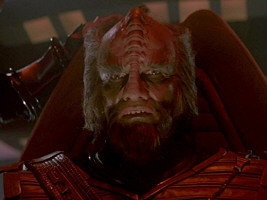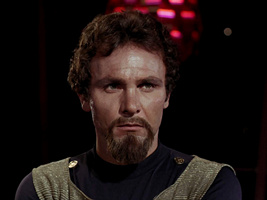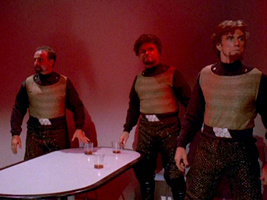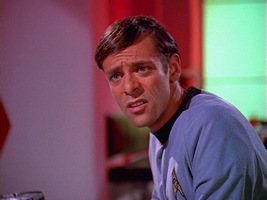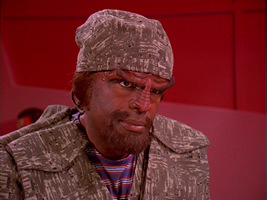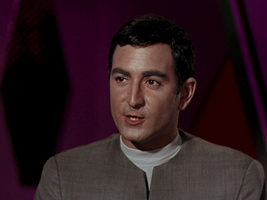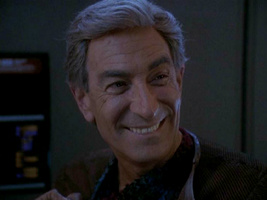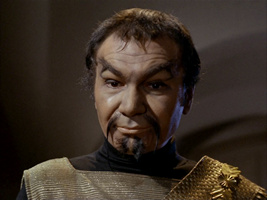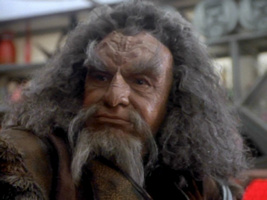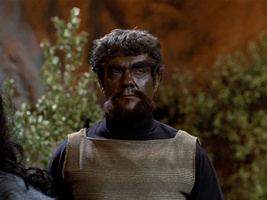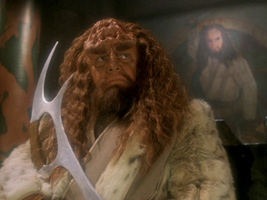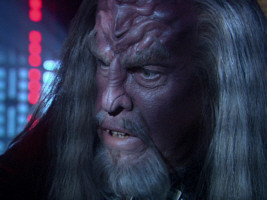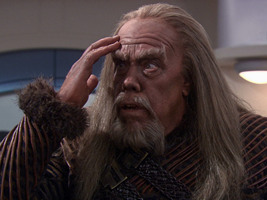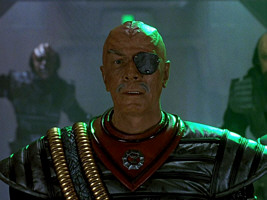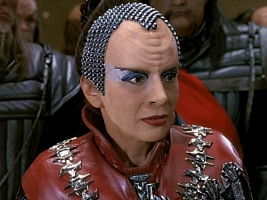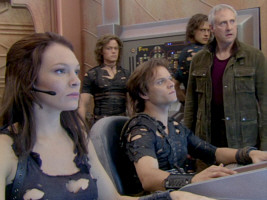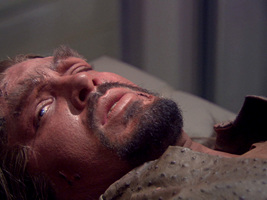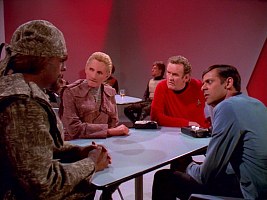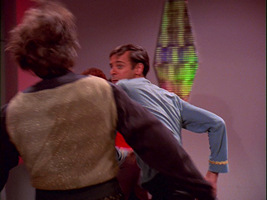The Klingon Forehead Problem
 Discovery Klingons are not discussed here. See the article on Discovery Klingons and Star Trek's Continuity.
Discovery Klingons are not discussed here. See the article on Discovery Klingons and Star Trek's Continuity.Most notably the make-up of the Klingons was modified for TMP. In TOS their foreheads were flat exactly like those of humans. The only distinguishing mark was their beards. In TMP and thereafter, however, the Klingons had ridges on their foreheads, to emphasize their being alien but probably also their martial nature.
It was supposedly Gene Roddenberry's intention that the Klingons species had always looked so, and that the technical and budgetary restrictions of the old series just didn't allow to show them with the desired sophisticated make-up. After all, we have to disregard other shortcomings of TOS likewise, such as the USS Constellation from "The Doomsday Machine" that looked on screen like the cheap plastic model it was and whose warp engines shook when the ship entered the Doomsday Machine. At the time of the movies and in TNG the simple and straightforward solution, in the ongoing Star Trek production as well as among fans, was to consider the flat-headed Klingons a visual deficiency of TOS that had to be ignored.
 For the remastered version of TOS most visual shortcomings and errors of the series were corrected, including all planets and starships. The Klingon look remained unchanged, however.
For the remastered version of TOS most visual shortcomings and errors of the series were corrected, including all planets and starships. The Klingon look remained unchanged, however.
The Problem
Since the DS9 episode "Trials and Tribble-ations" the rationale that the look of the TOS Klingons is just a technical shortcoming that we have to overlook has become hard to uphold. The divergence between TOS and TNG Klingons shows up in the direct comparison of the unaltered TOS Klingons from "The Trouble with Tribbles" on one hand and Worf on the other hand. Even the newly filmed Klingons in the episode don't have the forehead ridges.
Also, the divergence is explicitly hinted at in the DS9 episode. Odo, Bashir and O'Brien don't even recognize the TOS Klingons who are sitting next to their table in the bar on K-7 as Klingons:
Bashir: "Those are Klingons?"
Waitress: "All right. You boys have had enough."
Odo: "Mister Worf?"
Worf: "They are Klingons, and it is a long story."
O'Brien: "What happened? Some kind genetic engineering?"
Bashir: "A viral mutation?"
Worf: "We do not discuss it with outsiders."
Worf's statement that Klingons don't discuss the issue with outsiders raises more questions than it can answer.
In addition, the divergence is made an issue even before the TOS Klingons show up, when Worf finds out who Arne Darvin really is, and Jadzia comments on it:
Worf: " His real name is Arne Darvin. He is a Klingon altered to look human."
Dax: " His surgeon does nice work."
Why does Worf mention it as being something special that Arne Darvin, a Klingon, was altered to look like a human, although he has just found out that already young Darvin pictured on the screen looked human, just like all TOS Klingons and particularly the TOS Klingons later in the same episode? Why does Jadzia agree that it is a matter of surgery and not interject that Darvin may be just a remnant of the 23rd century? Of all crew members Worf, as a Klingon, as well as Jadzia, owing to Dax's age, must be well aware of the different looks of TOS Klingons.
The central problem is a statistical one. All TOS Klingons without exception had flat foreheads, whereas all Klingons in TMP and later without exception sported the characteristic ridges. The latter include the Klingons who have traveled to the Delta Quadrant (VOY: "Prophecy") and have probably embarked on their long journey just at the time of TMP. The appearance of Kirk's former adversaries Kang, Koloth and Kor in DS9: "Blood Oath" makes the explanation even more difficult. They must definitely have undergone a metamorphosis.
We also need to wonder why the Kahless clone in TNG: "Rightful Heir" looks like contemporary Klingons and not like the flat-headed fake Kahless in TOS: "The Savage Curtain". Maybe the TNG Kahless accordingly altered to look like present-day Klingons? The same may apply to Worf's statue of Kahless and Morath fighting who had ridged foreheads as well. If the Klingons had not always looked like that, maybe they were adapted in the same fashion as depictions of Jesus Christ from different eras show him in contemporary clothes of these times, probably to allow a better identification with the historical figure.
Until the fourth season of Star Trek Enterprise, all Klingons encountered in the new series, without a single exception, are ridged as well, confirming that this is the actual and only look of the Klingons. It looks like the flat-headed TOS Klingons never existed and that DS9: "Trials and Tribble-ations" was in error.
In spite of all this, the two fourth-season episodes ENT: "Affliction" and ENT: "Divergence" provide us with the ultimate explanation that there were (or would be) indeed flat-headed Klingons in the TOS era, giving broad hints that the children of the Klingon Augments and of all Klingons treated against the mutated virus would inherit their ridgeless foreheads.
There is a certain degree of variation among the ridged Klingons too. Their basic make-up was modified more than once in the course of the six TOS movies. Notably most Klingons who appeared in "Star Trek: The Undiscovered Country" had less pronounced forehead bones than most Klingons in the other movies. Star Trek settled to a final Klingon forehead style as we know it from DS9, VOY and ENT in later seasons of TNG. Until then even the very same character of Worf was subjected to a metamorphosis. But we may explain the slight change of his ridges with a normal aging process, in accordance with a visible tendency that older Klingons are likely to have more wrinkled foreheads. A commented gallery shows nearly all Klingon make-up variants that ever appeared.
"Affliction" and "Divergence"
In the two Enterprise episodes "Affliction" and "Divergence" we learn what has to be considered the ultimate truth about the appearance of the TOS Klingons. In 2154 the Klingon scientist Antaak, supervised by General K'Vagh, devises a program to use the genetic improvements of human Augments to create a new breed of Klingon warriors. Several Klingons, including K'Vagh's son Marab, volunteer to have themselves genetically altered. One of the side effects is that they lose their forehead ridges. But soon a new problem emerges. The Levodian flu, a usually rather harmless infection, mutates because of the human DNA and becomes airborne. The illness now threatens the lives of millions of Klingons. Based on the virus Dr. Phlox, who has been abducted by the Klingons, develops an antivirus. The antivirus takes away the genetic superiority from the Klingon Augments. Any other Klingon who is given the antivirus as a cure against the mutated virus loses his forehead ridges just like the Augments. Dr. Phlox says that the children of the so treated Klingons would inherit their look. Even if the trait were recessive, it would perfectly explain the existence of smooth-headed Klingon still more than a century later.
Although skeptics may object that the story arc with the Klingon Augments is still no proof for the existence of flat-headed Klingons still 100 years later, there are unmistakable hints in the two episodes that the Klingons treated with the antivirus are indeed the same type of Klingons that would be dominant in the TOS era. First of all, their looks are nearly identical. The Klingon Augments have dark skin and they otherwise look just like humans. Even their fashion doesn't seem to have changed in more than 100 years. We can see that these Klingons, most obviously Marab, have the kind of beards we know from the TOS era, and even their uniforms are similar to those of TOS Klingons. It is implausible that the smooth-headed Klingons would develop cultural distinctiveness so soon, still the broad hint was devised to dispel any doubts about the connection of the Enterprise arc to TOS. Furthermore, if possibly millions of Klingons are treated with the antivirus, lose their forehead ridges and pass on this trait to their children, we would expect them to still exist in the 23rd century.
Yet, it is harder to explain why there are several entire starship crews composed only of these flat-headed Klingons in the 23rd century. It would be more plausible if the Empire either integrated the smooth-headed Klingons or killed them. Racial segregation doesn't exactly seem to be the Klingon way. On the other hand, the flatheads could have isolated themselves mostly voluntarily. We have to bear in mind that there are different castes and houses with their own ships and troops already among the ridgeheads. Moreover, we can assume that major Klingon houses are affected by the plague as well, which would justify that flat-headed Klingons hold some power in their hands in the 23rd century even if their sight is not accepted. This, however, is only possible if the trait is dominant and if there are no mixed families.
Furthermore, one aspect of the otherwise silly notion that the flat-headed Klingons were intended to spy on the Federation may help us find an explanation. According to "Divergence" they all retain some human DNA, and at some point the Klingon Defense Force may have decided that these Klingons were the best to deal with the human-dominated Starfleet. It still wouldn't explain why we don't see a single "real" Klingon in TOS though. It is also possible that, because of their human DNA, the flatheads themselves may have a special interest in dealing with humans in one way or another, so it wouldn't be surprising to meet many of them on ships near the Federation borders. On the other hand, the leadership of the Defense Force may be rather concerned about possible fraternization with humans.
Side note While the origin of the smooth-headed Klingons as outlined in the two Enterprise episodes sounds very similar as the obsolete theory 2 (illness) in the addendum, the outcome of the episodes could lead to much the same implications in the 23rd century as described in theory 1 (two races). So our considerations are not really useless since the principal question about the Klingon foreheads was answered.
The metamorphosis of Kang, Koloth and Kor may be justified rather easily. If smooth-headed Klingons were still commonplace in the 2260's, a fast progress in cosmetic surgery may have allowed most of them to have their foreheads reconstructed until 2271. Probably no Klingon would forgo such an opportunity. It is quite plausible that until the time of TNG not a single flat-headed Klingon would be left. But this would also imply that prior to 2268 there was no efficient technique to restore the foreheads. A genetic therapy for an authentic reconstruction of the ridges may turn out futile once the virus or antivirus strikes back and flattens the forehead again. But what about cosmetic surgery, a simple procedure that is already available on 21st century Earth? Even if we imagine that Klingon plastic surgery is far behind human standards, it would be somewhat ridiculous if the Klingons were not capable of enlarging their forehead bones with simple implants. The only reason for not getting them might be that Klingons are not fond of fake things (the plastic ridges would be like silicone boobs).
"Trials and Tribble-ations"
Only one puzzle is left, but this is rather a peculiarity of DS9: "Trials and Tribble-ations" than a general problem. The episode was made well before the ultimate explanation of the Klingon forehead dilemma in Enterprise. Yet, it didn't stick to the silent agreement of the time that Klingons always looked the same. The DS9 episode bluntly commented on the then obvious divergence that was not supposed to exist.
We may try to find individual excuses for Odo's, O'Brien's and even Dr. Bashir's alarming lack of knowledge about 23rd century Klingons. Maybe Odo as an outsider, who never had any courses in galactic history, really doesn't know how some or many 23rd century Klingons looked like (although at some point he should have encountered old pictures of Klingons in the course of his meticulous investigations). Miles O'Brien may have been a lousy history student who was only interested in technical matters, but we would still expect him to recall such a fundamental fact once it is directly pointed out to him by Worf. It seems unlikely that he could have missed or forgotten about a depiction of human-looking Klingons, for this would be something very memorable from a human point-of-view. Bashir, who was still keeping the secret of being genetically enhanced, on the other hand, may have wanted to evade the topic of genetic engineering that was cropping up and hence played the ignoramus. On the other hand, it is no apology for their failure to identify Klingons that O'Brien and Bashir likewise mistook a relatively low-ranking Enterprise crew member for Captain Kirk. After all, knowing rank signs from 100 years ago is rather special knowledge, even for a Starfleet officer, and the two would not have been the first ones who failed to recognize someone whom they had seen only on photos.
However, it is not just a matter of insufficient history lessons. Odo, O'Brien as well as Bashir apparently don't even recognize 23rd century Klingons when they are sitting next to them. In a bar full of Klingons their conduct and the sound of their language (not to mention the smell) must have given away what species they are - irrespective of the activation of a universal translator. Furthermore, they have been briefed before boarding the station and must have expected them to arrive.
Worf's quibbling in the bar, on the other hand, is quite understandable. The existence of generations of Klingons without one of the most typical Klingon traits is not exactly a glorious chapter of their history in retrospect.
Worf's and Jadzia's statement that Darvin underwent plastic surgery seems pointless, assuming that the two of all crew members should be familiar with how TOS Klingons used to look like. Curzon Dax knew the three flat-headed Klingons Kang, Kor and Koloth, and it seems improbable that none of them would have ever told their Trill friend of the secret. On the other hand, Worf may have known from the spy's biography that he was indeed surgically altered, and Jadzia may for once have decided not to waste too much time talking.
It can be interjected that the Federation and the Klingons may have come to an agreement to remain silent about a disreputable chapter of their common history. But would the Federation or Starfleet ban the topic from school or Academy lessons, respectively, or even delete all evidence from publicly accessible archives? And would other races censor evidence about the Klingons whenever Federation citizens request access to their data? Unquestionably not. Like already in our time, nothing that is common knowledge with visual evidence will ever vanish from archives - especially if it is so interesting and historically relevant. While the Klingon appearance can't have remained a secret, it is still possible that the chapter about the Klingon disease is not common knowledge in the 24th century, like many of the Klingon customs and rituals that were shown or referred to since the beginning of TNG were unfamiliar to the Enterprise crew and had to be explained by Worf.
Yet, perhaps the solution to the dilemma lies in assuming the exact contrary. Starfleet officers may be well aware how Klingons looked in the 23rd century. But there may be a directive not to talk about it with Klingons, just because Klingons are obviously very sensitive about that chapter of their history and "don't discuss it with outsiders". So Jadzia certainly recognizes Worf's little white lie about Darvin being "altered", and ironically comments on it instead of correcting him in front of the other officers. In the bar, O'Brien, Bashir and maybe Odo too may have been following the directive by the letter (or have a silent agreement among themselves) until the point when their denial of the obvious truth becomes ridiculous. It is only questionable whether upholding a directive when it is unavoidable to break it sooner or later, as well as treating Worf like a fool on a critical mission is the right thing to do. And regarding Worf, he has been to Starfleet Academy, and I can't imagine that Starfleet's knowledge about 23rd century Klingons as well as the directive to other students to pretend ignorance was kept secret from him all the time.
Abramsverse
 The Klingon who takes off his mask in "Star Trek In to Darkness" has forehead ridges. Although we couldn't expect otherwise, this look does not comply with the one of TOS and with the facts established in ENT: "Divergence", that the antivirus that was created from human Augment genes would genetically alter Klingons to look like humans. This one Klingon may be an exception, but there wasn't a single exception among dozens of Klingons we could see in TOS. Overall, it is just too obvious that the masks were just included as an additional dramatic effect to emphasize that the Klingons in this universe are different than some may have expected them to be.
The Klingon who takes off his mask in "Star Trek In to Darkness" has forehead ridges. Although we couldn't expect otherwise, this look does not comply with the one of TOS and with the facts established in ENT: "Divergence", that the antivirus that was created from human Augment genes would genetically alter Klingons to look like humans. This one Klingon may be an exception, but there wasn't a single exception among dozens of Klingons we could see in TOS. Overall, it is just too obvious that the masks were just included as an additional dramatic effect to emphasize that the Klingons in this universe are different than some may have expected them to be.
Conclusion
With the facts established in ENT: "Affliction" and "Divergence", it is irrevocable that the smooth-headed Klingons of TOS actually existed and that we are not entitled to disregard the divergence. There is no reason to still believe that there were never any smooth TOS Klingons, and that it was just a make-up shortcoming of TOS.
Two problems definitely remain. The first is why we couldn't see a single ridge-headed Klingon in all of TOS. The second is why otherwise literate Starfleet officers don't recognize TOS Klingons (or just pretend not to recognize them?) when they see, hear and smell a dozen of them, knowing that a Klingon ship is around in DS9: "Trials and Tribble-ations". This is certainly not completely satisfactory, but no other theory could have completely explained away these two problems. Overall, we are left with a good story and a rather intelligent solution to the Klingon forehead dilemma in Star Trek Enterprise.
Addendum: Obsolete Theories
Until ENT: "Affliction" and "Divergence", there were various approaches to explain the metamorphosis of Klingon foreheads. Some of them were sensible, but most needed to be taken with a grain of salt. Theories included two different races, a plague, viral mutation, genetic engineering, fast evolution, cosmetic surgery as a fashion trend, cosmetic surgery to infiltrate/deceive the Federation and even a fancy of Q. However, none of them (maybe except for the Q theory :-D) was sufficient to solve the dilemma in its entirety. The most plausible solution used to be that there were at least two different types of Klingons existing or having existed in parallel.
The first useful theory was based on the assumption that the Klingon Empire consists of at least two races or species. This is no surprise, bearing in mind that the same applies to the Federation and even to the Romulans as seen in "Star Trek Nemesis". The races could have evolved on the same planet or one was subdued by the other. In the times of TOS, the smooth race may have been the dominating one in the Klingon fleet, as is the human species in Starfleet. Maybe their domination was restricted to the space along the Federation border, maybe they ruled the whole Empire at that time, maybe they even treated the ridgeheads like their slaves. Unfortunately these considerations became all more or less futile, seeing that Star Trek Enterprise exclusively showed ridged Klingons as early as in the 2150s, making it unlikely that they vanished until 2265, only to reappear vigorously until 2271.
Theory 1
The smooth Klingons may have been the ruling race. The presumable Klingon-Romulan alliance seems to be an important event in Klingon history in that era, since it incorporated a massive technology transfer, including Klingon D7-class battlecruisers for the Romulans and (presumably) cloaking technology for the Klingons. The treaty, however, seems to have been renounced some time later, and we can imagine that it was not a peaceful time. Either the Klingons were attacked by the Romulans, or a reactionary (bumphead) fraction of Klingons violated the treaty. In either case the smooth Klingons could have been stigmatized as traitors, for they were the ones who made the deal with the despised Romulans, and the bumpheads took over control of the Empire. The smooth Klingons were either killed or forced to have their heads altered to adapt to the new order. The uniform style was significantly changed some time between TOS and TMP likewise which could be a sign of a revolution. In the following decades, the bumpheads regarded the alliance and revolution as dishonorable, and they remained silent on it. So Worf did not want to discuss this topic with Bashir and O'Brien. Though Kang, Kor and Koloth are originally smooth Klingons, they were still held in high esteem due to their merits in battle, while the smooth diplomats were probably executed or dishonored.
A more peaceful (and maybe not Klingon-like) variant is that the smooth Klingons, who were only shown in a comparably small number of TOS episodes, were a kind of special task force to deal with the Federation, or they were just a regional "civil defense" force. It has often been suggested that certain Klingons were genetically or cosmetically altered to better deal with humans or to infiltrate the Federation. The stupidity of this idea becomes obvious if we consider that all of them (save Darvin in "The Trouble with Tribbles") were always posing as Klingons with typical beards and uniforms in typically Klingon ships. Thus, any similarity to the outer appearance of humans must be a coincidence. Maybe the smooth Klingon homeworld is located next to the Federation border. When the smooth Klingons could not defeat the Federation, they may have been replaced by "real" Klingon troops and subsequently been stigmatized as cowards. Maybe the smooth Klingons were ashamed about their failure, so they gave up their identity by changing their outer appearance to look like the tough ones. It is also possible that the number of smooth Klingons is very small compared to the "real" Klingons so it is no surprise that they do not reappear in TNG and DS9. Federation members such as the Andorians are rare throughout the Federation likewise, especially in Starfleet, though there are probably billions of them on their homeworld.
There was another quite reasonable theory that would have complied with both the statement in "Trials and Tribble-ations", as well as the appearance of Klingons in Enterprise (thanks to Raja Ramalingam):
Theory 2
"After watching a rerun of VOY: 'Prophecy', I've thought of a new Klingon forehead theory which I found very plausible: The Klingons in the episode suffered from the nehret, a degenerative disease that infects only their species. The Doctor was able to ultimately cure the disease using the Human/Klingon hybrid stem cells of B'Elanna's unborn daughter. Since the Klingons had been journeying for a century, it may be that the nehret had been epidemic throughout the Empire when they originally left for the Delta Quadrant (pre-TOS era). Klingon scientists, in subsequent years discovered the cure for the disease lie in genetic makeup of their Human adversaries. Not being as skilled as Voyager's Doctor in genetic manipulation (which would've maintained the ridges), Klingons may have been subject to gene therapy on a wide scale, of which smooth foreheads was a side effect. After all Klingons had been purged of the disease through this method (post-TOS era), they were reverted to their natural state by the time of TMP. I doubt if the creators will ever use this theory, but it seems the most plausible one to me, aside from Q or something."
Matt Koenig adds the following considerations:
"After reading the Klingon forehead portion of the inconsistency section I realized that there might, in fact, be something of a transitional Klingon. The delegation that comes aboard the Enterprise in Star Trek VI seems to have extremely varied forehead styles. General Chang and the Chancellor's daughter are the two that really stand out as having the least pronounced ridges with Chang's head being almost humanly flat. I know that this was probably just a matter of the films production and doesn't really have anything to do with the forehead problem, especially since it's 5 films late, but it is a somewhat satisfying answer to me. There is something to be said about the ridge patterns for the first batch of new Klingons, though. Maybe I just need to watch the film again, but the Klingons in TMP all have just about the same ridge pattern to them. Again, this is no doubt a production issue as the makeup technique was new and developing different ridge patterns might not have been within budget considerations, but it does seem to fit into the idea that the absence of ridges was side effect of the cure for sort of genetic disease. The Klingons in TMP may have been previously ridge-less individuals who underwent an early version of this reparation surgery."
See Also
The Evolution of Klingon Foreheads - fairly complete gallery and commentary
Star Trek Enterprise - Season 4
Credits
Thanks to Raja Ramalingam for his idea about the nehret and to Ambassador/Ensign_Q for hints about "Trial and Tribble-ations". Some aspects in the update have been provided by Timo Saloniemi in the Flare Forums and by MarshallDog. Thanks also to Torche for the suggestion that Starfleet has a directive or silent agreement not to mention their knowledge of the divergence to the Klingons.






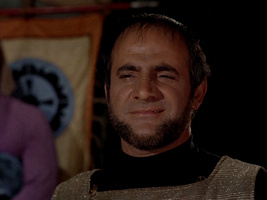
 Kras in TOS: "Friday's Child"
Kras in TOS: "Friday's Child"